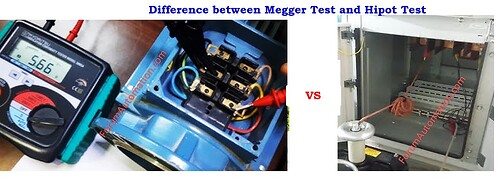Difference between Megger Test and Hipot Test
Megger Test (Insulation Resistance Test)
A Megger test is generally used to determine the insulation resistance (IR) of electrical components such as
It helps in the detection of
- Insulation deterioration,
- Moisture infiltration and
- Contamination all of which can cause electrical failures.
During the test, a DC voltage is put across the insulation (often 500V, 1000V or 2500V depending on equipment rating) and the resistance is measured.
High resistance shows good insulation, whereas low resistance suggests problems. This test is critical in preventative maintenance programs to ensure the long-term dependability of electrical systems.
Standards for the Megger Test:
IEC 60364-6: Electrical Installations - Insulation Resistance Measurement Guidelines.
IEEE 43: Recommended Practice for Testing Insulation Resistance in Rotating Machines.
IS 3347/IS 60034-27: Indian Standards for Electrical Machine Insulation Resistance Testing.
Hipot Test (High Potential/Dielectric Strength Test)
A Hipot test is used to assess the dielectric strength of insulation by introducing a high AC (or) DC voltage (much greater than the normal operating voltage) between conductors and ground (or) between phases. The test determines whether the insulation can resist overvoltage circumstances without failure. Hipot testing is routinely used to ensure the safety and compliance of cables, transformers, motors, switchgear and other high-voltage equipment. in comparison to the Megger test, the Hipot test concentrates on withstand capabilities rather than simply measuring resistance.
Standards for Hipot Testing:
IEC 60060-1 defines high-voltage test methodologies and specifies their general requirements.
IEEE 95: Standard for high-voltage testing of electrical equipment.
IS 307 / IS 2026 are Indian standards for dielectric testing of electrical equipment.
Difference between Megger Test and Hipot Test
Megger Test vs Hipot Test
| Feature | Megger Test | Hipot Test |
|---|---|---|
| Purpose | Measures insulation resistance of cables, motors, transformers, and electrical equipment. Helps identify deteriorated insulation. | Checks dielectric strength of insulation. Determines if insulation can withstand high voltage without breakdown. |
| Test Type | Low voltage DC test (typically 250V, 500V, 1kV, 5kV depending on equipment rating). | High voltage AC or DC test (often 2–5 times the normal operating voltage). |
| Measured Parameter | Insulation resistance in ohms or megaohms (MΩ). | Pass/fail: insulation withstands high voltage or breaks down (no direct resistance measurement). |
| Purpose in Maintenance | Preventive maintenance: detects insulation degradation before failure. | Acceptance or commissioning test: ensures insulation can handle surges and operating stresses. |
| Typical Equipment Tested | Motors, transformers, cables, switchgear. | Transformers, cables, switchgear, capacitors, motors. |
| Voltage Stress on Equipment | Relatively low; safe for slightly energized or sensitive components. | High; can stress insulation. Equipment must be isolated and discharged after testing. |
| Safety Consideration | Generally safer; less likely to damage insulation. | Can damage insulation if voltage is too high or applied for too long; safety precautions are critical. |
| When Used | Routine preventive maintenance and troubleshooting. | Commissioning, post-repair testing, insulation verification. |
You can also follow us on AutomationForum.co, Facebook and Linkedin to receive daily Instrumentation updates.
You can also follow us on ForumElectrical.com , Facebook and Linkedin to receive daily Electrical updates.
